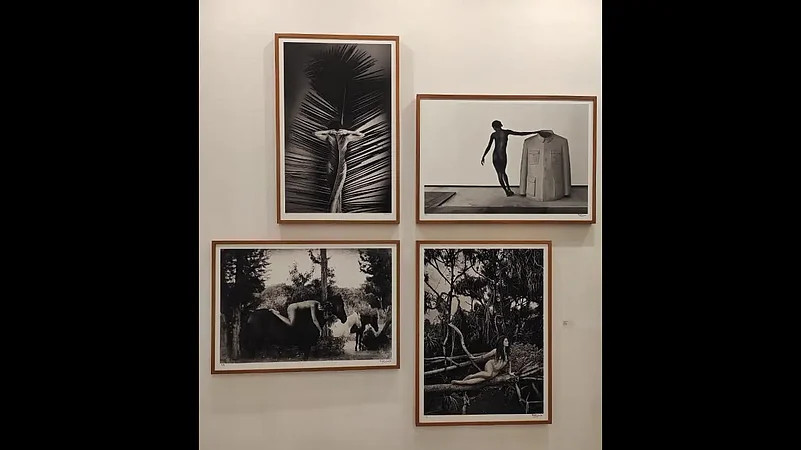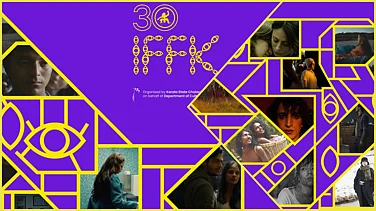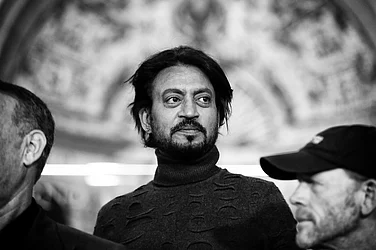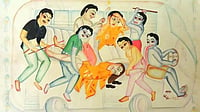Harmut Wurster is stoked, surprised and has a twinge of regret that he could have kept more artworks on standby. By the evening of Day 2 at India Art Fair, his booth of contemporary platform ZOCA was a complete sellout. The display consisted of a series of 100 paintings themed Garden of East on the juxtaposition of past and present histories using miniature school elements by Ahmedabad-based artist Jignesh Panchal. Plus, five temple architecture-inspired works by paper wizard Kulu Ojha from Odisha. The highest price of an artwork sold from his booth went for a little over Rs 21 lakh.
"It is overwhelming but I have no works to sell now," laughs the gallerist, wondering how to bide his time for the next two days of the fair at NSIC Grounds, Okhla, ending on Sunday, May 1. "We were even contemplating getting more artworks from Ahmedabad, but realised it's too much of a hassle, especially since it is so hot right now, we are melting."
ZOCA always raked in good sales at the previous art fair editions, says Wurster, but never sold out and this quickly. "I think the appealing aesthetics of colour, imagery and intimate spaces by both artists really played on people's minds. It really matters what you hang at a fair of this scale." The arts promoter says he always picks up artists rooted in their culture but have a contemporary, global language. "So the art can be displayed in New York or New Delhi but should be discernible where the artist comes from."

Other participants at the 2022 edition are also riding high on great sales, and like in ZOCA's case, better than the pre-pandemic editions. The four-day event—hosting 79 exhibitors, including 65 galleries and 14 institutional participants—being viewed as a litmus test of post-pandemic Indian art market as gallerists and their artists faced severe hardships in the last two years from lack of funds, work, physical display and client interactions, along with the personal health, safety and trauma of losing loved ones to Covid. Against major hiccups, like a cutback on international galleries largely because of increased travel and shipments costs because of cumbersome Covid protocols, exhibitors are pleasantly surprised with the rocking sales and are relieved to have taken the risk of coughing up an expense to occupy booth space.
"We have almost sold everything!" replies Director Sunitha Kumar Emmar of Gallery Skye. The sold works include one of the fair highlights—Hyderabad-based Faiza Hasan's charcoal explorations of her family history. Other works that sold include Mumbai artist Sunil Padwal's wall installation of 50 frames titled If Absence Could Speak that contain found objects right from his growing years; a bunch of ceramic garlands by The Netherlands/India artist Rajyashri Goody whose works vocalise the Dalit resistance; Abir Karmakar's Covid-era humanless landscape titled Twin Tanks; and few frames from Somnath Bhatt's 10 new artworks of gouache on Japanese handmade Kozo paper series.
Sunaina Anand of Art Alive Gallery says in the group display of 17 artists titled Transmutations, a Thota Vaikumtan work went for Rs 30 lakh; and a post Covid comment by Vipul Badva titled Interconnected Lives has sold for Rs 1.5 lakh. Few pieces of a whole display have sold from the Sakti Burma's series each priced at Rs 2.5 lakh; photographer Rohit Chawla's black and white photographs for Rs 2.5 lakh each and Anil Thambai's architectural wall works in graphite on multi-coloured hemp for Rs 75,000 each. IAF debutant artist Meghna Singh Patpatia, who creates using a fascinating lineup of materials—gold, rice paper, canvas and ink—has sold a few and has high chances of her glass installations being sold for Rs 1.75 lakh.
Anand says the buying patterns were quite interesting this year. "What's different this time is the collectors' interest in younger contemporary artists', their variety of mediums and themes, and the thought to collect them young, which is quite exciting. Yesterday (Day 1) was when most of the visitors came to look at most of these senior artists, and in that viewing happened to spot younger artists' works. So they bought senior artists' works yesterday, but have come back today to relook at younger contemporaries. When you see something new, unexpected, you need time to process and comprehend it. So it usually takes a little longer to collect younger artists' works, but this time it's working better than before." Anand thinks the pandemic has had a role to play in this shift in buying attitudes. "After the pandemic, people's perspective on life has changed. They want to do things in the now, and this has reflected even in their method of collecting art. The audience for art has widened."

In agreement about the refreshing and changing buyer response is Mandira Lamba of the South Asia focus gallery Blueprint12, currently celebrating its 10th anniversary, who was initially apprehensive of showing at this fair edition, but is glad to have risked it and had "super response" on all 10 artists. The dainty etched imageries on used books by Nepalese paper artist Youdhisthir Maharjan, all four works by Meghna Gavireddygari with political undertones, Vipeksha Gupta's charcoal and graphite works on paper from her FOLD series, and largescale work by Sri Lankan artist Kingsley Gunatillake have all been bought. "The highlight of this year is the vengeance with which young, dynamic high networking individuals (HNIs) have visited and and really supported the artists. They are very experimental, have done their research but don't come with preconceived notions of how an artwork should be." This mindset has helped in forging sales for the Integrated Arts Forum, that Blueprint 12 runs in collaboration with Exhibit 320, and which saw sales for their collection of tribal art works and textile traditions. "We had zero expectations from this booth because if we had foreign collectors who are usually attracted to traditional works for their exotic aura, but again the young Indian collectors surprised us." Her personal highlight is the sale of two largescale Warli artworks by Sada Shiv and Balu Mashe, sons of the late National Award winning artist, Jiyve Some Mashe.
In previous editions, Ankon Mitra, known for his largescale origami works, would display two-three works, and usually have a sellout by the Day 4. This time he has a single-artist booth display for Art Positive, and by Day 2, has already sold two works, and has reserved two out of the displayed seven works in goat leather, Kasavu sari, terracotta, and other materials. A work of two flying birds depicting the Greek legend of Icarus and Daedelus sold for Rs 4.5 lakh, while a walk-in mirror-room installation priced at Rs 18 lakh is on reserve. "During the pandemic, people had time to build or complete their farmhouses because their businesses had halted and they were at home. They finished these projects and now want to populate these spaces with art works. Most of the ones who bought and reserved my works are from this group," observes Mitra.
Mumbai-based Rukshaan Krishna of the eponymous art initiative, a beacon for Baroda-based mid-career artists, was one of the last exhibitors to leave the display booths last night. She was busy uninstalling sold artworks and replacing them with new works. Krishna says she undid the gallery’s usual single-artist booth format to accommodate two artists—Sanjay Barot and Ajay Dhapa—long associated with the gallery, and does not regret it. Two out of three Barot artworks—each in his signature-style frame bearing 75 medallions of portraits— and three of Ajay Dhapa works have sold between Rs 4.5 lakh to Rs 12 lakh. "A few days ago, work on the art fair structure was paused due to a dust storm. Everybody at this art fair has faced challenges this year, but truth and beauty are never hidden for long, and good artists will do well."
One reason why the sales have skyrocketed this year is because the Covid interlude gave enough time for galleries to pre plan their IAF editions, feels Anand. Throughout the course of last year, she and her artists did a back and forth in prepping quality works to be displayed at the 2022 edition. With the last two years of sitting at home with no pressures of holding one show after the other, artists and gallerists got enough time to "evaluate their work and declutter their minds,” which is why "the quality of art across has really improved. "Even as gallerists, our programming has become more structured, planned and focused. Earlier, we did not know how to say no. As gallerists and artists we used to take up projects we didn't want but were pushed or coaxed into doing so, and got caught up in back to back work with no time to pause. Now we have learnt to say no."


























